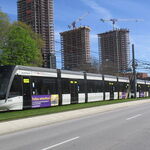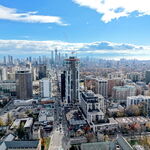I don't think there's any point in this. The Richmond Hill Line will never amount to much more than a miniature commuter railway. It's never going to get all-day service because its inevitably going to be duplicated by a Yonge subway extension. Who will want to take the TTC to Leslie and then the Go Train to Union, when the time saved (assuming the destination is Union Station) is about the same as the time it takes to walk between the two stations even if there is a tunnel built, and you have to wait for the train to arrive?
For both the city and the province, it's a much better use of resources to expand the parking lot at Oriole so more people will take the train during rush hour rather than driving down the DVP. While they're at it, maybe add a direct entrance from the 401 eastbound off-ramp to the parking lot.
Wrong.
The Richmond Hill Line goes to Yonge at Langstaff GO station.
Trust me, people will rather take the GO from this area to Union rather than the Yonge subway. Especially when the Richmond Hill line is switched onto the old CPR Don Branch, which will cut even more time off it.
It will be an express service while the Yonge subway will crawl along.
Elsewhere, there are precedents of what amounts to "express/allstop" metro systems elsewhere in the world. Paris' RER intermingling with Paris' Metro is one classic example, and the London CrossRail will also serve a somewhat similar purpose too.
I think that in 50 years, Yonge+DRL-Long will essentially need to be re-twinned yet again -- and Richmond Hill RER around ~2050-2060+ may very well serve this role. That's why Richmond Hill RER currently is a "After 2041" plan in the Metrolinx 2041 document.
DRL will only relieve temporarily, but induced demand and continued Toronto growth will simultaneously overwhelm both Yonge line _and_ DRL. That's what's currently happening in other cities (Beijing, Shanghai, etc) -- their DRL equivalents in other cities eventually go overflowing.
The induced demand phenomenon that happens to freeways also happens to a lot of heavily-trafficked transit routes through dense regions (aka downtown routings rather than Sheppard routings). You widen freeways, more people drive, cars fill up freeway. Same for downtown high-density subways in world cities -- you build more lines, they fill up. My prediction of the DRL is that, while it provides relief, induced demand will make these routes really busy, and we will need more routings.
Downtown "
Relief" Line, is an induced-demand recipe -- it's only a DTRL, not DRL -- "Downtown Temporary Relief Line". DRL and DRL-Long goes through areas that stand gradually densify quite significantly, and Yonge appears to continue to super-densify, so Yonge+DRL won't be enough in 30-50 years.
Certainly it is better city policy to build mass transit, as Yonge Subway alone,
moves more people per hour than an 8-lane-wide freeway, so better induced demand happens to subways than freeways.
Historically we had only one metro loop -- Line 2 intersecting the "U". In a couple of decades, we will have gridded/intersected our subway system massively more just like New York City, London, Paris, Beijing, Shanghai, and the gridding tends to have some major induced-demand effects (well observed in all those other major cities), as people gains more options of being able to go in either direction around various loops.
Toronto's skyscraper density is expected to almost double again in roughly ~20 years -- based on just the currently proposed/approved constructions -- alone -- that are already on the table -- not including 50 years worth of plans.
If Canada+Toronto is still a gangbusters place to live (compared to many places of the world elsewhere -- Canada has the potential to suffer less comparatively speaking from geopolitics & climate change) -- Toronto will still be growing then into its continued progress into a super-megalopolis, and Richmond Hill RER needs to be protected-for (e.g. Don Valley sub).
If DRL-Long gets crowded too (just like induced demand phenomenons being observed on a Beijing/Shanghai subway), we've got a fantastic further-relief backup -- Richmond Hill RER. Brilliant protecting-for. Kudos to whomever spent taxpayer money to buy up the Don branch
so incredibly cheaply -- in 50 years we may see this almost as prescient as the Prince Edward Viaduct 1918 protecting-for of the tracks under the bridge. That was originally called a white elephant but has been lauded and venerated since, having saved a huge amount of construction cost for the TTC Bloor-Danforth subway. In fact, it stands to save Toronto far more money than the famed 1918 PEV bridge decision (even inflation-adjusted!) -- being able to double as a DRL2 as Toronto's equivalent of a London-CrossRail expansion or Paris-RER expansion. Instead of spending CrossRail style costs, we have a bona-fide DRL2 corridor already, saving tens of billions.
There may be political shifts (e.g. Changing the sequence of: DRL-Long / Richmond Hill RER / Yonge Line Extension / etc) but the Richmond Hill RER needs to be kept in reserve as a useful express route later this century.
It's still cheaper than tunneling a 4-track Yonge Subway, anyway. And parallel routes are more sensible. That's the proper way to build relief routes. Other cities (including TODAY's Beijing and Shanghai -- are already building relief-line routes, in some cases a mere decade after their original parallel routes). Richmond Hill RER and Yonge Subway (extended) will interchange in Richmond Hill, so they will be connected at both ends, so that allows Richmond Hill RER to double as a 150kph super-express as part of the FRTN (Frequent Rapid Transit Network). This will likely be critically needed in 50 years. It's good to protect these corridors.







